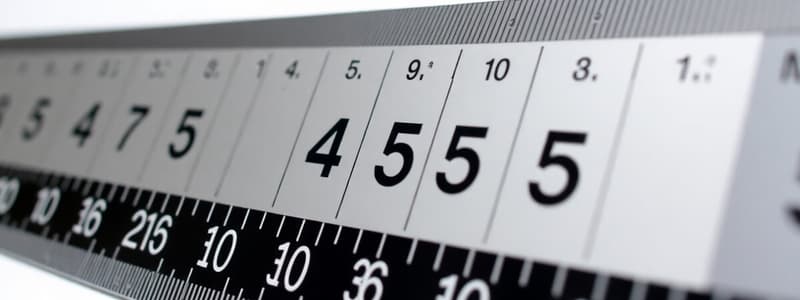Podcast
Questions and Answers
What is the basic standard for measurement called?
What is the basic standard for measurement called?
unit
What are the fundamental or base quantities' units known as?
What are the fundamental or base quantities' units known as?
fundamental or base units
Which of the following is NOT one of the fundamental base units?
Which of the following is NOT one of the fundamental base units?
- Metre
- Second
- Pound (correct)
- Kilogram
Match the following systems of units with their base units for length, mass, and time:
Match the following systems of units with their base units for length, mass, and time:
What is the SI system of units?
What is the SI system of units?
The SI units use a decimal system.
The SI units use a decimal system.
What are the additional units in SI defined for plane angle and solid angle?
What are the additional units in SI defined for plane angle and solid angle?
Define the base quantity for length in the SI system.
Define the base quantity for length in the SI system.
Study Notes
Introduction to Units and Measurement
- Measurement involves comparing a physical quantity with a standard reference called a unit.
- The result of a measurement is expressed as a numerical value with a corresponding unit.
- There are fundamental (base) units for basic quantities like length, mass, and time.
- Other physical quantities can be expressed as combinations of base units, leading to derived units.
- A system of units encompasses both base and derived units.
The International System of Units (SI)
- SI is the internationally accepted system of units for measurement.
- It uses a standardized scheme of symbols, units, and abbreviations.
- The International System of Units (SI) uses a decimal system for conversions, making them simple and convenient.
Base Units in Different Systems
- The CGS System: Uses centimeter (cm), gram (g), and second (s) for length, mass, and time respectively.
- The FPS (British) System: Uses foot (ft), pound (lb), and second (s) for length, mass, and time respectively.
- The MKS System: Uses meter (m), kilogram (kg), and second (s) for length, mass, and time respectively.
SI Base Units and Definitions
- Length: The meter (m) is defined as the distance traveled by light in a vacuum during a time interval of 1/299,792,458 of a second.
- Mass: The kilogram (kg) is defined as the mass of the international prototype of the kilogram, a platinum-iridium alloy cylinder kept at the International Bureau of Weights and Measures (BIPM) in France.
- Time: The second (s) is defined as the duration of 9,192,631,770 periods of the radiation corresponding to the transition between the two hyperfine levels of the ground state of the cesium-133 atom.
- Electric Current: The ampere (A) is defined as the constant current that, if maintained in two straight parallel conductors of infinite length, of negligible circular cross-section, and placed 1 meter apart in vacuum, would produce between these conductors a force equal to 2 × 10−7 newton per meter of length.
- Temperature: The kelvin (K) is defined as 1/273.16 of the thermodynamic temperature of the triple point of water.
- Amount of Substance: The mole (mol) is defined as the amount of substance that contains as many elementary entities as there are atoms in 0.012 kilogram of carbon-12.
- Luminous Intensity: The candela (cd) is defined as the luminous intensity, in a given direction, of a source that emits monochromatic radiation of frequency 540 × 1012 hertz and that has a radiant intensity in that direction of 1/683 watt per steradian.
SI Supplementary Units
- Plane Angle (dθ): Unit is radian (rad). Defined as the ratio of arc length (ds) to the radius (r).
- Solid Angle (dΩ): Unit is steradian (sr). Defined as the ratio of the intercepted area (dA) of a spherical surface to the square of its radius (r).
Studying That Suits You
Use AI to generate personalized quizzes and flashcards to suit your learning preferences.
Related Documents
Description
Explore the fundamental concepts of units and measurement, including the importance of base and derived units. This quiz covers the International System of Units (SI) and different measurement systems, highlighting their significance in expressing physical quantities accurately.




